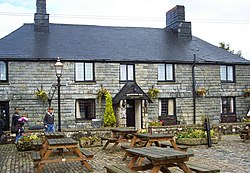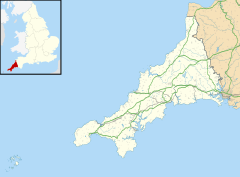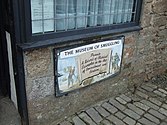
Bodmin Moor is a granite moorland in north-eastern Cornwall, England, United Kingdom. It is 208 square kilometres (80 sq mi) in size, and dates from the Carboniferous period of geological history. It includes Brown Willy, the highest point in Cornwall, and Rough Tor, a slightly lower peak. Many of Cornwall's rivers have their sources here. It has been inhabited since at least the Neolithic era, when early farmers started clearing trees and farming the land. They left their megalithic monuments, hut circles and cairns, and the Bronze Age culture that followed left further cairns, and more stone circles and stone rows. By medieval and modern times, nearly all the forest was gone and livestock rearing predominated.

Bolventor is a hamlet on Bodmin Moor in Cornwall, England, United Kingdom. It is situated in Altarnun civil parish between Launceston and Bodmin.

Cornwall is a ceremonial county in South West England. It is recognised by Cornish and Celtic political groups as one of the Celtic nations, and is the homeland of the Cornish people. The county is bordered by the Atlantic Ocean to the north and west, Devon to the east, and the English Channel to the south. The largest urban area in the county is a conurbation that includes the former mining towns of Redruth and Camborne, and the county town is the city of Truro.
Wrecking is the practice of taking valuables from a shipwreck which has foundered or run aground close to shore. Often an unregulated activity of opportunity in coastal communities, wrecking has been subjected to increasing regulation and evolved into what is now known as marine salvage.

Dame Daphne du Maurier, Lady Browning, was an English novelist, biographer and playwright. Her parents were actor-manager Sir Gerald du Maurier and his wife, actress Muriel Beaumont. Her grandfather George du Maurier was a writer and cartoonist.

Altarnun is a village and civil parish in Cornwall, England, United Kingdom. It lies 7 miles (11 km) west of Launceston on the north-eastern edge of Bodmin Moor at grid reference SX 223 811.

Jamaica Inn is a 1939 British adventure thriller film directed by Alfred Hitchcock and adapted from Daphne du Maurier's 1936 novel of the same name. It is the first of three of du Maurier's works that Hitchcock adapted. It stars Charles Laughton and Maureen O'Hara in her first major screen role. It is the last film Hitchcock made in the United Kingdom before he moved to the United States.

Jamaica Inn is a novel by the English writer Daphne du Maurier, first published in 1936. It was later made into a film, also called Jamaica Inn, directed by Alfred Hitchcock. It is a period piece set in Cornwall around 1815. It was inspired by du Maurier's 1930 stay at the real Jamaica Inn, which still exists as a pub in the middle of Bodmin Moor.

Bodinnick is a riverside village in south-east Cornwall, in the United Kingdom. According to the Post Office the population of the 2011 Census was included in the civil parish of Lanteglos-by-Fowey. It is a fishing village situated on the east bank of the River Fowey opposite the town of Fowey, also on the banks of the Fowey River. The ferry crossing is from Fowey to Bodinnick and the "Old Ferry Inn" is located on its bank glorified as "in the heart of Du Maurier country". This ferry terminal is said to have existed since the 13th century.

Rough Tor, or Roughtor, is a tor on Bodmin Moor, Cornwall, England, United Kingdom. The site comprises the tor summit and logan stone, a neolithic tor enclosure, many Bronze Age hut circles, and some contemporary monuments.
Jamaica Inn is a free house in Cornwall, England.

Menabilly is a historic estate on the south coast of Cornwall, England, situated within the parish of Tywardreath on the Gribben peninsula about 2 miles (3.2 km) west of Fowey.
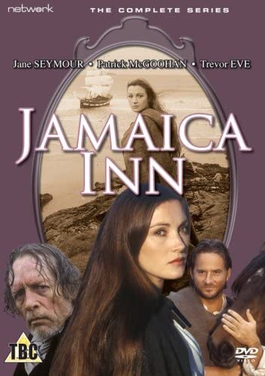
Jamaica Inn is a 1983 British television miniseries adapted from the 1936 novel Jamaica Inn by Daphne du Maurier. It is a gothic period piece of piracy, smuggling and murder set in northeastern Cornwall, England in the early 19th century. The series dramatizes the cultural trope of wreckers, clipper ship era pirates who employed various deceptions including mislocated lights, to lure ships to their doom on irregular rugged shorelines for subsequent plundering. It stars Jane Seymour, Patrick McGoohan and Trevor Eve and was directed by Lawrence Gordon Clark.

Launceston is a town, ancient borough, and civil parish in Cornwall, England, United Kingdom. It is 1 mile (1.6 km) west of the middle stage of the River Tamar, which constitutes almost the entire border between Cornwall and Devon. The landscape of the town is generally steep particularly at a sharp south-western knoll topped by Launceston Castle. These gradients fall down to the River Kensey and smaller tributaries.

St Nonna's Church, also known as the Cathedral of the Moors, is the second largest church on Bodmin Moor, Cornwall, located in the village of Altarnun. The dedication is to Saint Non or Nonna, who was the mother of St David. The church is mentioned in Daphne du Maurier's Jamaica Inn; it is the church in which the evil vicar of Altarnun Francis Davey depicts himself in a painting as a wolf while the members of his congregation have the heads of sheep.

Brown Willy is a hill in Cornwall, England, United Kingdom. The summit, at 1,378 feet above sea level, is the highest point of Bodmin Moor and of Cornwall as a whole. It is about 2+1⁄2 miles northwest of Bolventor and 4 miles southeast of Camelford. The hill has a variable appearance that depends on the vantage point from which it is seen. It bears the conical appearance of a sugarloaf from the north but widens into a long multi-peaked crest from closer range.

Kilmar Tor is an elongated hill, 396 metres (1,299 ft) high and running from SW to NE, on Bodmin Moor in the county of Cornwall, England. Its prominence of 118 metres qualifies it as a HuMP.
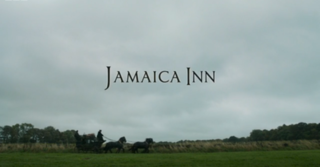
Jamaica Inn is a British drama television series that was first broadcast on BBC One for three consecutive nights from 21 to 23 April 2014. The three-part series, written by Emma Frost, is an adaptation of Daphne du Maurier's 1936 gothic novel Jamaica Inn set in Cornwall. It was poorly received, becoming a subject of controversy and making national news over its mumbling cast and other sound problems.
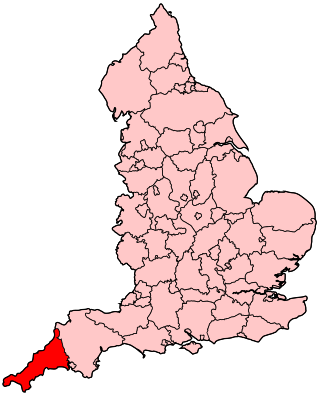
The following outline is provided as an overview of and topical guide to Cornwall: Cornwall – ceremonial county and unitary authority area of England within the United Kingdom. Cornwall is a peninsula bordered to the north and west by the Celtic Sea, to the south by the English Channel, and to the east by the county of Devon, over the River Tamar. Cornwall is also a royal duchy of the United Kingdom. It has an estimated population of half a million and it has its own distinctive history and culture.
Presented below is an alphabetical index of articles related to Cornwall:

